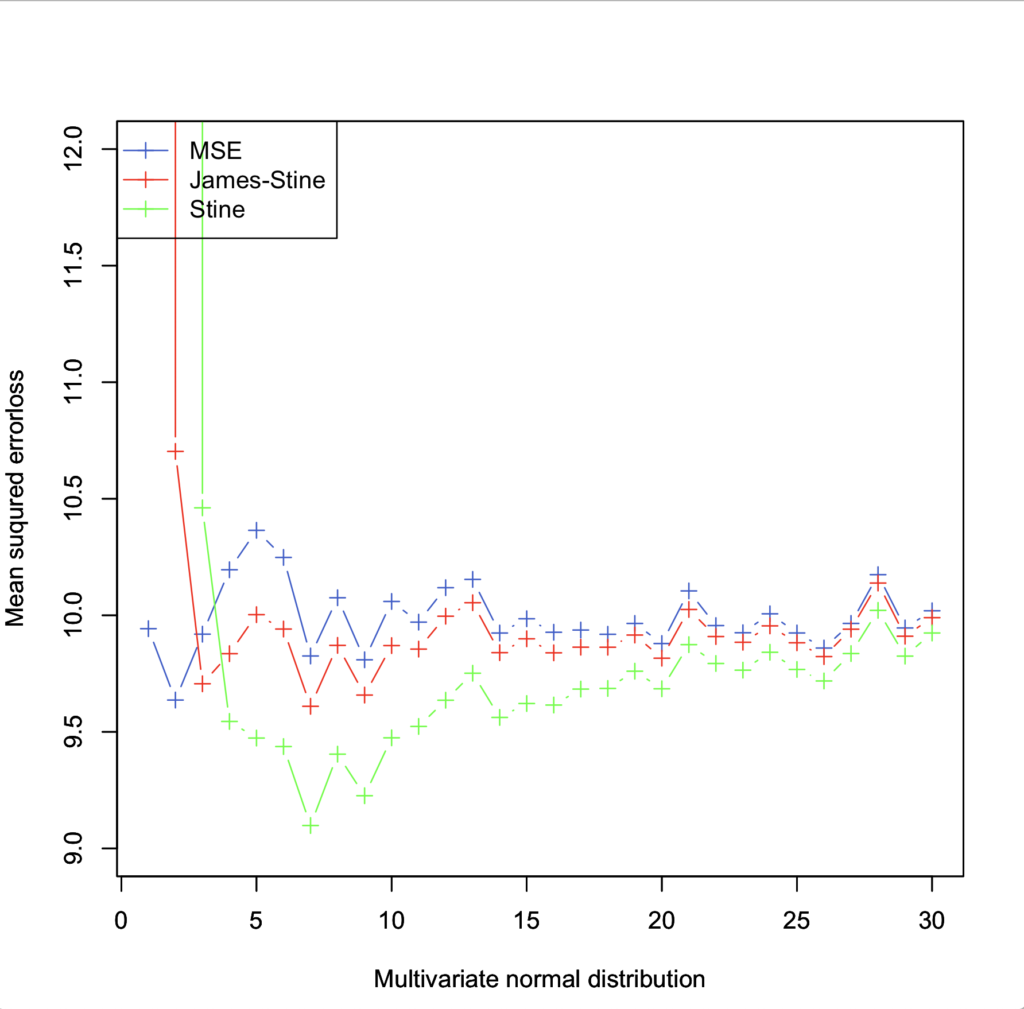summary
I was learning about Stein estimation from a friend of mine, and when I was studying machine learning, I saw the term “Stein estimator” written somewhere in a paper, so I decided to study estimators. I still do not understand the proof of why the Stein estimator reduces the error, so I will continue to study it,
What is Stein Presumption?
It is one of the methods that can provide more accurate estimates than the least squares method when many population means are estimated simultaneously. It is a kind of so-called reduced estimator. Suppose that there are mothers
,
,
, , ,
and that for each
we observe independent random variables
,
, , ,
that follow a normal distribution
with variance
. The natural estimator of
is
itself, and
is a minimum variance unbiased estimator and a maximum likelihood estimator. When trying to estimate
based on
, we basically base it on the mean squared error
. At this time, whatever the value of
is, it is said that there is no estimator that is smaller than the sum of the MSEs.
However, when is greater than 3, there exists an estimator such that the sum of the MSEs is smaller. That is the James-Stein estimator. However, when
, z is admissible, and for
, z is non-admissible and is improved by the James-Stein estimator.
※ denotes the Euclidean norm. Furthermore, the Stein estimator, which can be better estimated than the James-Stein estimator, consists of the following equation.
Validation (James-Stein estimator and MSE)
The following R program creates samples that follow a normal distribution with variance
for each
for 10 populations
,
, , ,
(1,2,3, , ,10) respectively. To compare the estimation, the sum of the MSE and James-Stein estimator for each sample is the expected value of the squared error
I would like to compare the estimates with the difference in
n <- 10 mu <- 1:n sig <- 1 try_num = 1000 mat <- matrix(0, 1, 2) ## n個のサンプルを発生させる
tmp <- rnorm(n, mu, sig) xx<-norm(tmp, type="2")^2 ## James-Stein推定値を求める
Stein <- (1-(n-2)/(xx)) * tmp ## 結果を保存
mat[1, 1] <- sum((Stein - mu)^2)/n # James-Stein推定値を用いた二乗誤差の期待値
mat[1, 2] <- sum((tmp - mu)^2)/n # データそのものを用いた二乗誤差の期待値
paste("James-Stein : ", mean(mat[, 1])) paste("MSE : ", mean(mat[, 2]))We found that the James-Stein estimation had a smaller squared error by doing the following number of times.
> paste("James-Stein : ", mean(mat[, 1])) [1] "James-Stein : 0.566820964708058" > paste("MSE : ", mean(mat[, 2])) [1] "MSE : 0.598717547433325"
> paste("James-Stein : ", mean(mat[, 1])) [1] "James-Stein : 0.697318338422813" > paste("MSE : ", mean(mat[, 2])) [1] "MSE : 0.680173749274679"Next we will try 1000 attempts.
n <- 10 mu <- 1:n sig <- 1 try_num = 1000 mat <- matrix(0, try_num, 2) ## 1000回実行します
for(i in 1:try_num){ ## サンプルを発生させる
tmp <- rnorm(n, mu, sig)
xx<-norm(tmp, type="2")^2 ## スタイン推定値を求める
Stein <- (1-(n-2)/(xx)) * tmp ## 結果を保存する
mat[i, 1] <- sum((Stein - mu)^2)/n # スタイン推定値を用いた二乗誤差の期待値
mat[i, 2] <- sum((tmp - mu)^2)/n # データそのものを用いた二乗誤差の期待値
}
paste("Stein : ", mean(mat[, 1])) paste("MSE : ", mean(mat[, 2]))As a result, the Stein estimate has a smaller expected value of squared error than the James-Stein estimate.
> paste("Stein : ", mean(mat[, 1])) [1] "Stein : 0.980164575967686" > paste("MSE : ", mean(mat[, 2])) [1] "MSE : 0.994713532652209"Verification (when N increases)
I would like to visualize how each estimate changes when the number of matrices
,
,
, , ,
increases from 1,2,3…. I would like to visualize how each estimate changes as
increases from 1,2,3….
MSE<-c(0,0,0,0,0,0,0,0,0,0,0,0,0,0,0,0,0,0,0,0,0,0,0,0,0,0,0,0,0,0)
j_s<-c(0,0,0,0,0,0,0,0,0,0,0,0,0,0,0,0,0,0,0,0,0,0,0,0,0,0,0,0,0,0)
s<-c(0,0,0,0,0,0,0,0,0,0,0,0,0,0,0,0,0,0,0,0,0,0,0,0,0,0,0,0,0,0)
S1<-0
S2<-0
S3<-0
n <- 30
sig <- 1
try_num = 1000
mat <- matrix(0, try_num, 3)
for(j in 1:n){
mu <- 1:j
for(i in 1:try_num){
## サンプルを発生させる
tmp <- rnorm(j, mu, sig)
xx<-norm(tmp, type="2")^2
## James-stein推定値を求める
if(j>2){
j_stein <- (1-(j-2)/(xx)) * tmp
}else{
j_stein <- (1-(1)/(xx)) * tmp
}
## stein推定値を求める
if(j>3){
s_2 <- (1/(j-3)) * sum((tmp - mean(tmp))^2)
a <- (sig)^2 / s_2
stein <- (1-a)*tmp + (a/j)*sum(tmp)
}else{
s_2 <- sum((tmp - mean(tmp))^2)
a <- (sig)^2 / s_2
stein <- (1-a)*tmp + (a/j)*sum(tmp)
}
## 結果を保存する
S1 <- S1 + sum((tmp - mu)^2)/j # データそのものを用いた二乗誤差の期待値
S2 <- S2 + sum((j_stein - mu)^2)/j # スタイン推定値を用いた二乗誤差の期待値
S3 <- S3 + sum((stein - mu)^2)/j # データそのものを用いた二条誤差の期待値
}
MSE[j] <- S1/100
j_s[j] <- S2/100
s[j] <- S3/100
S1<-0
S2<-0
S3<-0
}
print(MSE)
print(j_s)
print(s)
z<-1:30
plot(z,MSE,xlab="Multivariate normal distribution",ylab="Mean suqured errorloss",pch=3,ylim=c(9,12),type="b",col="royalblue3")
par(new=T)
plot(z,j_s,xlab="Multivariate normal distribution",ylab="Mean suqured errorloss",pch=3,ylim=c(9,12),type="b",col="red")
par(new=T)
plot(z,s,xlab="Multivariate normal distribution",ylab="Mean suqured errorloss",pch=3,ylim=c(9,12),type="b",col="green")
legend("topleft",
legend=c("MSE", "James-stein", "stein"),
pch=c(3,3,3),
lty=c(1,1,1),
col=c("royalblue3", "red", "green")
)
The results show that Stein estimation < James_Stein estimation < MSE and the squared error is less, indicating that Stein estimation is a better estimation.
> print(MSE)
[1] 9.893811 10.061190 10.201689 9.991315 10.099179 9.872469 9.984524 10.109032 10.170069 9.929639 10.090521 10.132484 10.112773
[14] 9.938398 9.938122 10.129706 10.003247 9.966152 9.884785 9.984538 9.998484 9.988337 9.895186 9.989390 9.991495 10.203533
[27] 10.052179 9.987638 9.908004 10.070632
> print(j_s)
[1] 1670.078472 11.068689 9.930817 9.705076 9.762386 9.590761 9.726514 9.909983 9.943457 9.762370
[11] 9.961938 10.015718 9.997933 9.850449 9.864478 10.045977 9.931580 9.881776 9.816021 9.915127
[21] 9.959294 9.935525 9.850859 9.950460 9.958395 10.168994 10.009156 9.950454 9.874517 10.045453
> print(s)
[1] NaN 1.399345e+06 1.174287e+01 1.004977e+01 9.381920e+00 9.156616e+00 9.240040e+00 9.404127e+00 9.449622e+00 9.308097e+00
[11] 9.572499e+00 9.637781e+00 9.720924e+00 9.597115e+00 9.675648e+00 9.830977e+00 9.691651e+00 9.719077e+00 9.626047e+00 9.749151e+00
[21] 9.801033e+00 9.801899e+00 9.749940e+00 9.828186e+00 9.872554e+00 1.003455e+01 9.914897e+00 9.867066e+00 9.815286e+00 9.956238e+00
> 
summary
I was learning about Stein estimation from a friend of mine, and when I was studying machine learning, I saw the term “Stein estimator” written somewhere in a paper, so I decided to study estimators. I still do not understand the proof of why the Stein estimator reduces the error, so I will continue to study it,